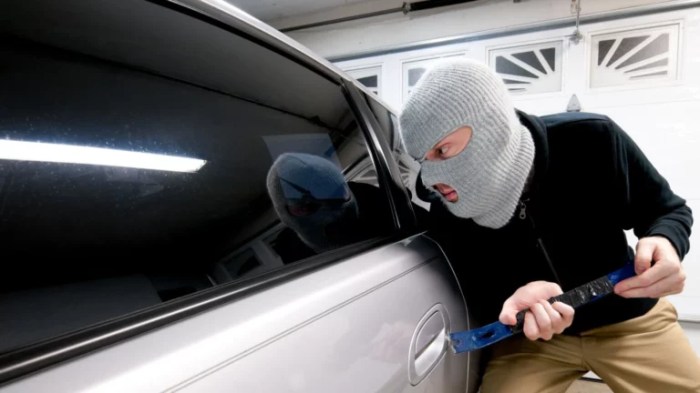Car theft is a significant concern for vehicle owners, impacting not only their personal safety and financial well-being but also their insurance premiums. Understanding the intricate relationship between car theft and insurance costs is crucial for making informed decisions about vehicle security and insurance coverage. This guide delves into the various factors that influence how car theft affects your insurance premiums, offering insights into risk assessment, claim history, geographic location, vehicle features, and driver behavior.
From the meticulous risk assessment methods employed by insurance companies to the impact of anti-theft devices and safe driving practices, we will explore the multifaceted nature of this issue. We will also examine the different types of insurance coverage available and how they respond to theft claims, providing a clear picture of how to mitigate the financial consequences of vehicle theft.
Impact of Car Theft on Insurance Risk Assessment

Insurance companies meticulously assess the risk of car theft when determining your premiums. This involves a complex evaluation of various factors, ultimately aiming to predict the likelihood of your vehicle being stolen and the potential cost of any resulting claims. The higher the perceived risk, the higher your premium will be.
Insurance companies use sophisticated actuarial models and vast databases of claims data to analyze risk. This allows them to identify patterns and trends, enabling them to accurately price insurance policies based on the probability of a claim.
Factors Considered in Risk Assessment
Several key factors influence an insurance company’s assessment of car theft risk. These factors are weighted differently depending on the insurer and the specific circumstances. Understanding these factors can help you understand why your premium might be higher or lower than someone else’s.
Specific Risk Factors and their Influence on Premiums
The make and model of your car significantly impact your premium. Certain vehicles are statistically more prone to theft than others, often due to their value, popularity among thieves, or the ease with which they can be stolen. For example, luxury vehicles and models known for their advanced technology or easily bypassed security systems generally attract higher premiums. Conversely, older, less desirable models might attract lower premiums. Your location also plays a crucial role. Areas with higher crime rates and more frequent car thefts naturally result in higher premiums. This is because insurers face a statistically greater chance of having to pay out claims in high-risk zones. Finally, the security features of your vehicle are a major consideration. Vehicles equipped with advanced anti-theft systems, such as immobilizers, alarms, and tracking devices, are generally considered lower risk and may qualify for discounts.
| Risk Factor | Impact on Premium | Example | Mitigation Strategy |
|---|---|---|---|
| Car Make and Model | Higher premium for high-theft risk vehicles; lower for less desirable models | A high-value sports car will have a higher premium than a compact sedan. | Consider less desirable models or those with advanced security features. |
| Location | Higher premiums in high-crime areas | Living in a city with a high car theft rate will lead to higher premiums than living in a rural area. | Consider parking in secure garages or well-lit areas. |
| Security Features | Lower premiums for vehicles with advanced security systems | A car with an immobilizer, alarm system, and GPS tracking device will likely have a lower premium. | Install aftermarket security systems or choose a vehicle with comprehensive security features. |
| Driving Record | Higher premiums for drivers with a history of accidents or violations | A driver with multiple speeding tickets or a DUI might face higher premiums. | Maintain a clean driving record. |
Relationship Between Claim History and Premiums

Your car insurance premium is significantly influenced by your claim history, particularly theft claims. Insurers assess risk based on past events, and a history of theft, regardless of fault, generally leads to higher premiums. This is because insurers view repeated theft claims as an indicator of higher risk, potentially due to factors such as the vehicle’s location, security measures, or even the driver’s behavior.
Insurers use sophisticated algorithms to analyze claim data and adjust premiums accordingly. The process typically involves reviewing the details of each theft claim, including the circumstances surrounding the event, the value of the vehicle, and whether the vehicle was recovered. This information is then fed into a model that calculates the increased risk associated with the policyholder and adjusts the premium to reflect that increased risk. The adjustment is usually an increase, reflecting the higher probability of future claims.
Premium Adjustments After a Theft Claim
Following a car theft claim, your insurer will conduct a thorough investigation. Factors considered include the date and location of the theft, whether the vehicle was recovered, the extent of damage (if any), and the value of the vehicle at the time of theft. Based on this assessment, the insurer will determine the appropriate premium adjustment. This adjustment is usually implemented at the next renewal period, but in some cases, it may be applied immediately. The increase isn’t arbitrary; it’s calculated using actuarial data that reflects the increased risk associated with the claim. For instance, a claim involving a high-value vehicle stolen in a high-crime area will likely result in a more substantial premium increase than a claim involving a low-value vehicle recovered quickly with minimal damage.
Premium Increases for Different Theft Claim Types
The impact of a theft claim on your premium depends significantly on whether the vehicle was recovered and the condition of the vehicle upon recovery. A recovered vehicle, even with damage, typically results in a smaller premium increase than a vehicle that is never recovered. This is because the insurer’s financial loss is considerably less when the vehicle is recovered. An unrecovered vehicle represents a total loss for the insurer, leading to a more substantial premium increase to offset the higher risk. Furthermore, claims involving multiple thefts or those linked to suspicious circumstances may trigger even larger increases. For example, a policyholder with a recovered vehicle might see a 15-20% increase, while a total loss claim could lead to a 30-40% or even higher increase, depending on the insurer and specific circumstances.
Impact of Multiple Theft Claims
Multiple theft claims within a short period, say within two to three years, will significantly impact your premiums. Insurers will view this as a pattern of high-risk behavior, drastically increasing the perceived risk. Consider this scenario: A driver experiences their first car theft and their premiums increase by 20%. Two years later, the same driver experiences another theft. The second theft claim will likely result in a more substantial premium increase, potentially 40-50% or even more, depending on the circumstances and the insurer’s risk assessment model. This demonstrates the compounding effect of multiple claims on premiums; each subsequent claim adds to the insurer’s perception of risk and leads to larger premium increases. In extreme cases, insurers might even refuse to renew the policy, leaving the driver to seek coverage from a different provider, potentially at even higher rates.
Impact of Driver Behavior on Car Theft and Insurance

Driver behavior plays a significant role in determining the likelihood of a car being stolen, directly impacting insurance premiums. Insurance companies meticulously assess various aspects of a driver’s habits and actions to gauge their risk profile and set appropriate premiums. Understanding this relationship empowers drivers to make informed choices that can lead to lower insurance costs.
Insurance companies consider a range of driver behaviors when assessing car theft risk. These extend beyond driving skill to encompass parking habits and vehicle maintenance practices. These factors, often overlooked, significantly contribute to the overall risk profile and, consequently, the premium a driver pays.
Parking Habits and Theft Risk
Parking habits are a key factor in determining car theft risk. Leaving a vehicle in poorly lit or isolated areas significantly increases the chance of theft. Similarly, leaving valuables visible inside the car acts as an irresistible temptation for thieves. Insurance companies analyze claims data to identify patterns linking specific parking locations and theft incidents. This data informs their risk assessment models, resulting in higher premiums for drivers who consistently park in high-risk areas. For example, drivers who regularly park on dimly lit streets late at night might face higher premiums compared to those who park in well-lit garages or driveways. This is because statistical analysis reveals a strong correlation between such parking habits and increased theft rates.
Vehicle Maintenance and Security Measures
Proper vehicle maintenance and the implementation of effective security measures are also considered. Neglecting regular maintenance, such as failing to repair broken locks or windows, signals vulnerability to thieves. Conversely, installing visible security systems, like alarms or tracking devices, can deter theft and lead to lower premiums. Insurance companies often offer discounts for drivers who have installed anti-theft devices, reflecting the reduced risk associated with these security measures. For instance, a driver with a comprehensive alarm system and an immobilizer might receive a significant discount compared to a driver whose car lacks these features. This directly translates to lower insurance costs.
Safe Driving Practices to Reduce Theft Risk
Several safe driving practices can significantly reduce the likelihood of car theft. These include always locking the vehicle, even for short periods; parking in well-lit and populated areas; avoiding leaving valuables in plain sight; and utilizing anti-theft devices. Furthermore, regularly servicing the vehicle and ensuring that all locks and windows are in good working order are crucial preventative measures. These simple steps can drastically decrease the probability of theft.
Insurance Company Incentives for Safe Driving
Many insurance companies actively incentivize safe driving habits to lower premiums. Some offer discounts for drivers who complete defensive driving courses or install telematics devices that monitor driving behavior. These devices can track driving habits like speed, acceleration, and braking, providing data that insurers use to assess risk. Drivers with consistently safe driving records, as measured by these devices, often qualify for lower premiums. Other insurers may offer discounts for drivers who demonstrate a history of responsible vehicle maintenance and security practices, further highlighting the interconnectedness between driver behavior and insurance costs.
Last Point
In conclusion, the impact of car theft on insurance premiums is multifaceted, influenced by a complex interplay of risk factors. Understanding these factors—from vehicle characteristics and geographic location to driver behavior and claim history—empowers car owners to make informed choices regarding vehicle security and insurance coverage. By implementing preventative measures and selecting appropriate insurance policies, individuals can significantly reduce their risk and mitigate the financial impact of potential car theft. Proactive security measures and responsible driving habits can ultimately lead to lower premiums and greater peace of mind.
Detailed FAQs
What if my stolen car is never recovered? How will this affect my premiums?
A non-recovered stolen vehicle will generally lead to a significantly higher premium increase compared to a recovered vehicle. The insurer considers the total loss a greater risk.
Does filing a false claim for car theft impact my future premiums?
Filing a fraudulent claim is a serious offense and will result in immediate policy cancellation and likely a refusal of future coverage from most, if not all, insurers. Your driving record will also be negatively affected.
Can I lower my premiums by installing additional security features after purchasing my insurance policy?
Many insurers offer discounts for installing aftermarket security systems. Contact your insurer to inquire about potential premium reductions. Providing proof of installation is usually required.
How often are insurance premiums reassessed based on car theft data?
The frequency varies by insurer and location but generally occurs annually at renewal time, sometimes incorporating more frequent adjustments based on significant changes in risk factors like a surge in local car thefts.